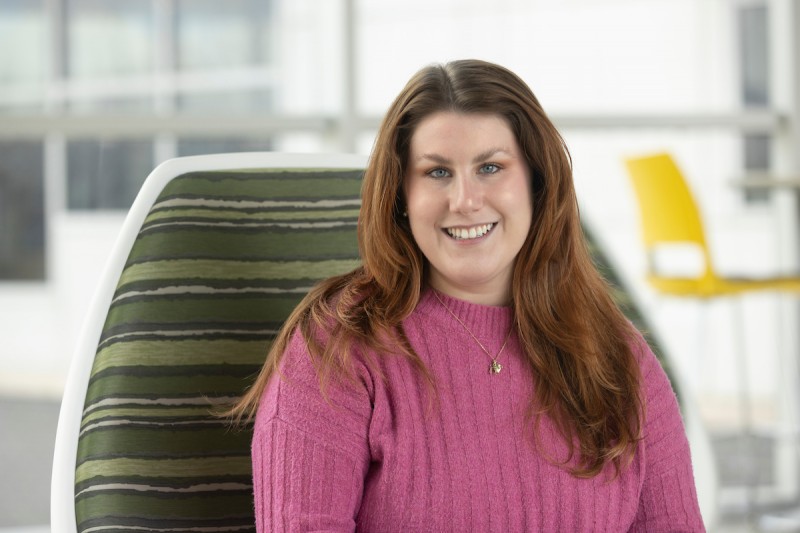Student at home in the lab and the orchestra
Biochemistry major Miriam Franks is preparing for a career in medicine — with a side of music

“Multifaceted” may be the best word to describe Miriam Franks, an orchestral flutist working in two different labs — one focused on harvesting overexpressed gene proteins and the other concerned with increasing hepatitis vaccination rates.
An Illinois native, Franks came to Binghamton University to realize her dream of living on the East Coast and her goal of becoming a doctor. Now, she’s a graduating senior majoring in biochemistry and minoring in music, finalizing her enrollment in SUNY Upstate Medical University, which she chose in part due to its proximity to an orchestra.
Her enthusiasm for research stems back to a high school experience with her older brother. Both were a part of their specialized school’s Student Inquiry and Research (SIR) program, which allowed them to collaborate with different STEM labs and health clinics. Franks worked with CRISPR/Cas9 gene editing tools and mixed lineage leukemia in breast cells. It was the project that set her on the path of cancer research.
“My brother had done the SIR program at our high school and did a really cool project about looking for differences in brain structure of those with Alzheimer’s,” Franks said. “He got to work with rat brains and present his project at conferences so I decided I wanted to do that, too.”
With graduation on the horizon, Franks is focused on completing her duties in the labs where she works. At the Guthrie Clinic, she and her mentor, Gastroenterology Fellow Alex Miller, are narrowing down methods to increase the rates of hepatitis A and B vaccinations, specifically among adult patients with Chronic Liver Disease (CLD). Miller’s original goal for the project was to look at the overall population of those with CLD and to raise the vaccination rates holistically. Franks introduced the idea of finding groups within the population who may need the vaccine more urgently than others, and potentially targeting them first.
“She very thoughtfully brought in additional components that we could look at simultaneously,” Miller said. “She took us a step further and said, ‘Why don’t we introduce different types of healthcare disparities out there? That way we can see if there’s one population more vulnerable and not only increase vaccine rates but also try to focus on those in the highest need.’”
This opened the team up to looking into patient demographics, giving the researchers more insight into the types of aid and communication they would need to administer alongside the vaccination. Due to her significant contribution, Franks is in charge of data extraction for the project.
“A lot of people can learn different aspects of medicine, but what I appreciated from Miriam is that she was always willing to learn, always willing to help out however she could, and she would actively seek out tasks,” Miller said. “That’s not something that can be learned — it’s innate.”
Besides her work at Guthrie, Franks is also involved in a biochemistry lab under Susan Bane, biochemistry program director. Franks emailed her the summer before her first year at Binghamton.
“I’ve had a couple hundred undergraduate research students over the years, and never have I been contacted that early,” Bane said. “She’s planning a long way ahead and is someone who’s thought carefully about what she wants to do and the steps she needs to get there. Yet, she also focuses on what she wants to do at the moment. She isn’t doing research just to get into med school; Miriam does it because she genuinely loves it.”
In that lab, Franks is working with a partner to isolate tumor overexpressed gene (TOG) proteins from genetically modified Escherichia coli cells. They have to grow the cells themselves and then break down their membrane walls, resulting in the release of TOG protein. This is all done as a way to harvest tubulin, the main constituent of living cells’ microtubules and a primary target for many cancer medications. It’s foundational research but Bane calls it critical, as the lab had yet to attempt to collect microtubules from cancer cells.
Franks has mastered the art of splitting her attention between her two passions: research and music. When she isn’t in the lab, she’s playing the flute. She took up the instrument at age 7 and has continued to play during her college career, most notably in “The Child and the Enchantments” and “The Magic Flute.”
“I’ve been playing the flute for 16 years,” Franks said. “I started originally because my mom played the flute when she was younger so we already had one in the house. It was natural for me to follow in my mom’s footsteps so I started band in the second or third grade and I’ve been in band or orchestra ever since. I was in a few community orchestras once I got a bit older and I really found my place in it.”
Franks said she is grateful so many people at Binghamton have invested in her success.
“The grad students have been amazing whenever I’m facing setbacks,” she said. “They helped me learn how to use equipment and I can ask them how to do certain equations. Of course, Dr. Bane, as well, she’s been pivotal to this entire experience. At Guthrie, working with Dr. Miller and getting to shadow him as he went through his daily tasks as a fellow really solidified for me that I want to do that, too.”
This story originally appeared in Binghamton Discover-e.

